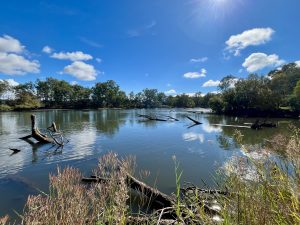Finally some rain to end the month after a dry autumn! But hopefully you were able to enjoy the sunny days out and about in our beautiful local region while they lasted (because surely we’re in for some more rain soon…). Anyway, on to what treasures and amazing scenery were spotted this past month.
This huntsman spider’s egg sac was found at Swainsona Conservation Reserve. Produced by the female, the sac of papery silk contains up to 200 eggs. In some species the female will stand guard over the sac, during which time she doesn’t eat at all. Other species will carry their egg sac underneath their bodies. Incubation time will vary with species and climate but the young spiderlings generally stay with their mother for several weeks.

Another creation made with silk that you may have noticed is this type of cocoon made by the caterpillars of various species of case moths. Along with silk, things like bits of leaves, sticks, and even sand and tiny stones are attached to aid in camouflage. This one has attached itself to a native cherry (or cherry ballart; Exocarpos cupressiformis) along the walking track at Swainsona. Endemic to Australia, these trees gain extra nutrients by attaching their roots to host plants when they are young. The bright red fruits that these trees produce are actually swollen stems! They have a very high sugar content and are favored by many birds including silvereyes, mistletoe birds, satin bowerbirds, grey butcherbirds, honeyeaters, currawongs, and parrots which help to disperse the seeds in their droppings.


Also spotted at Swainsona was this native parasitic wasp. There are two families of parasitic wasps – the Braconidae of which there are 800 species in Australia; and the Ichneumonidae of which there are around 2000 Australian species. While some of these wasps are tiny, some are large and colourful. The females lay their eggs inside the living host, usually the larval stages of butterflies, moths, and beetles. The young wasps then have a ready-made meal when they hatch! The adults are not so creepy, feeding on nectar and pollen. The wasp pictured here is an Ichneumonid wasp.

Our Whistle Stop High Tea event along the High Country Rail Trail between Huon Reserve and Tallangatta could not have had more perfect weather to show off some beautiful views, including the Sandy Creek bridge and sparkling waters of Lake Hume. The delicious food supplied by the Bonegilla and Tallangatta Rail Trail Advisory Groups topped it all off. Meanwhile, the upper stretches of the High Country Rail Trail provide quite different scenery and boast a total of 14 timber trestle bridges. These can be found between Bullioh and Corryong and some can be accessed via nearby carparks. Featured here are the bridges closest to Koetong. The Boggy Creek bridge has a carpark and picnic table, from which it is a 300 m walk to the bridge. Constructed in 1915, it’s one of the larger bridges and is a beautiful example. There are also a few other bridges which are within walking distance from a small parking area just outside of Koetong along Edgars Rd.


Closer to Wodonga, the Ryans Lagoon wetlands are a lovely spot for some bird-watching and peaceful contemplation. Listed as a nationally significant wetland, this area is under the management of the Duduroa Dhargal Aboriginal Corporation (DDAC) and provides a training ground for Aboriginal people in traditional land management. You can read more about what the DDAC have achieved at Ryans Lagoon here.


To close out this month’s edition of ‘Noticing Nature’, here are a few snaps from the Granite Walking trail on McFarlanes Hill – stay tuned for the next ‘Focus on Trails’ article highlighting more of this walk!








